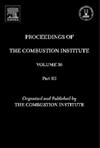On the Z-shaped explosion limits of acetylene-oxygen mixtures
IF 5.3
2区 工程技术
Q2 ENERGY & FUELS
引用次数: 0
Abstract
The explosion limits of the acetylene-oxygen (CH-O) mixture have been investigated and it is demonstrated, for the first time, that the CH-O explosion exhibits a Z-shaped response in the pressure-temperature regime with three distinct limits from low to high pressures, which resembles the explosion limits of hydrogen-oxygen (H-O) mixtures. Kinetic analysis shows that the is mainly controlled by the reaction of CH (+ M) = HCC (+ M) and the subsequent pathways of HCCHCOH. The second and third limits are controlled by the H-addition reaction of CH to form the CH radical. The CH radical is less reactive at intermediate pressures, and its pressure dependent formation, CH + H (+ M) = CH (+ M), results in the . However, CH radical is reactivated at high pressures through CH + HO = CH + O, from which the HO radical formed activates the HOHOOH chain branching channel, leading to the . Further, we explored the explosion limits of the H-CH-O mixtures, which shows that with increasing H concentrations, the explosion limit curve rotates clockwise around a . Such rotation only occurs in the second and third limits, while the first limit basically coincides with that of the CH-O system. The kinetic reasons responsible for the observed behavior are identified through the competing pathways of H and CH. Furthermore, the effects of changing of equivalent ratio, dilutions of nitrogen and water, with and without surface reactions on the explosion limits are also discussed. The results of the present work are useful to better understand the explosion limits of CH-O and H-CH-Omixtures and further study of more complex hydrocarbon fuels.关于乙炔-氧气混合物的 Z 型爆炸极限
研究了乙炔-氧气(CH-O)混合物的爆炸极限,首次证明 CH-O 爆炸在压力-温度体系中呈现 Z 型响应,从低压到高压有三个不同的极限,这与氢氧(H-O)混合物的爆炸极限相似。动力学分析表明,爆炸极限主要由 CH (+ M) = HCC (+ M) 反应和 HCCHCOH 的后续途径控制。第二和第三个极限受控于 CH 形成 CH 自由基的 H-加成反应。在中间压力下,CH 自由基的反应性较低,其形成与压力有关,即 CH + H (+ M) = CH (+ M),导致.CH(+M)。 然而,在高压下,CH 自由基通过 CH + HO = CH + O 重新活化,由此形成的 HO 自由基激活了 HOHOOH 链的分支通道,导致.CH(+M)。此外,我们还探讨了 H-CH-O 混合物的爆炸极限,结果表明,随着 H 浓度的增加,爆炸极限曲线会围绕 . 的位置顺时针旋转,这种旋转只发生在第二和第三极限,而第一极限与 CH-O 系统的爆炸极限基本一致。通过 H 和 CH 的竞争途径,确定了导致观察到的行为的动力学原因。此外,还讨论了改变当量比、氮和水的稀释、有表面反应和无表面反应对爆炸极限的影响。本研究的结果有助于更好地理解 CH-O 和 H-CH-O 混合物的爆炸极限,以及进一步研究更复杂的碳氢化合物燃料。
本文章由计算机程序翻译,如有差异,请以英文原文为准。
求助全文
约1分钟内获得全文
求助全文
来源期刊

Proceedings of the Combustion Institute
工程技术-工程:化工
CiteScore
7.00
自引率
0.00%
发文量
420
审稿时长
3.0 months
期刊介绍:
The Proceedings of the Combustion Institute contains forefront contributions in fundamentals and applications of combustion science. For more than 50 years, the Combustion Institute has served as the peak international society for dissemination of scientific and technical research in the combustion field. In addition to author submissions, the Proceedings of the Combustion Institute includes the Institute''s prestigious invited strategic and topical reviews that represent indispensable resources for emergent research in the field. All papers are subjected to rigorous peer review.
Research papers and invited topical reviews; Reaction Kinetics; Soot, PAH, and other large molecules; Diagnostics; Laminar Flames; Turbulent Flames; Heterogeneous Combustion; Spray and Droplet Combustion; Detonations, Explosions & Supersonic Combustion; Fire Research; Stationary Combustion Systems; IC Engine and Gas Turbine Combustion; New Technology Concepts
The electronic version of Proceedings of the Combustion Institute contains supplemental material such as reaction mechanisms, illustrating movies, and other data.
 求助内容:
求助内容: 应助结果提醒方式:
应助结果提醒方式:


